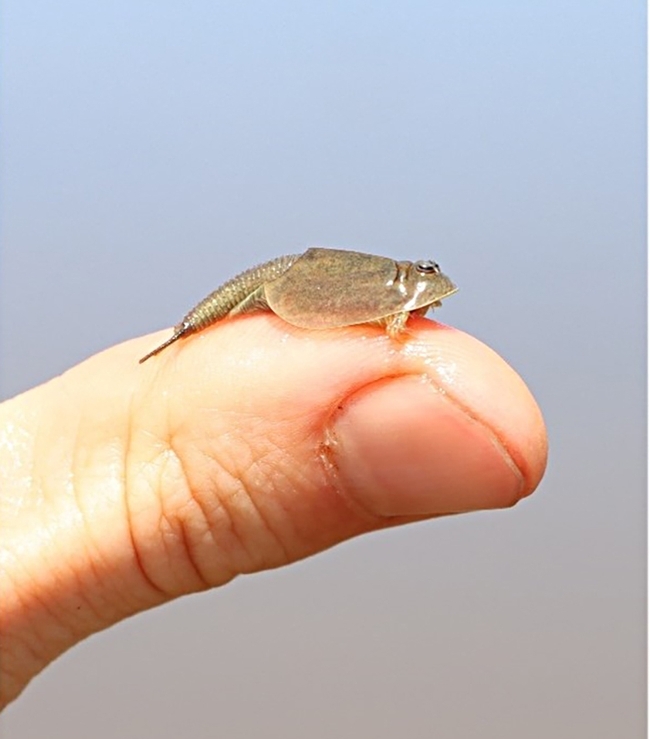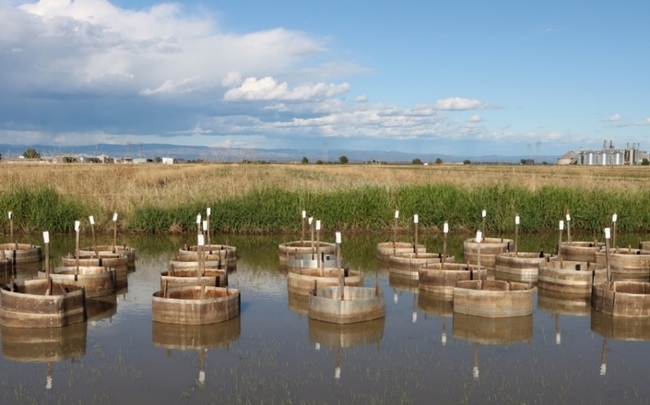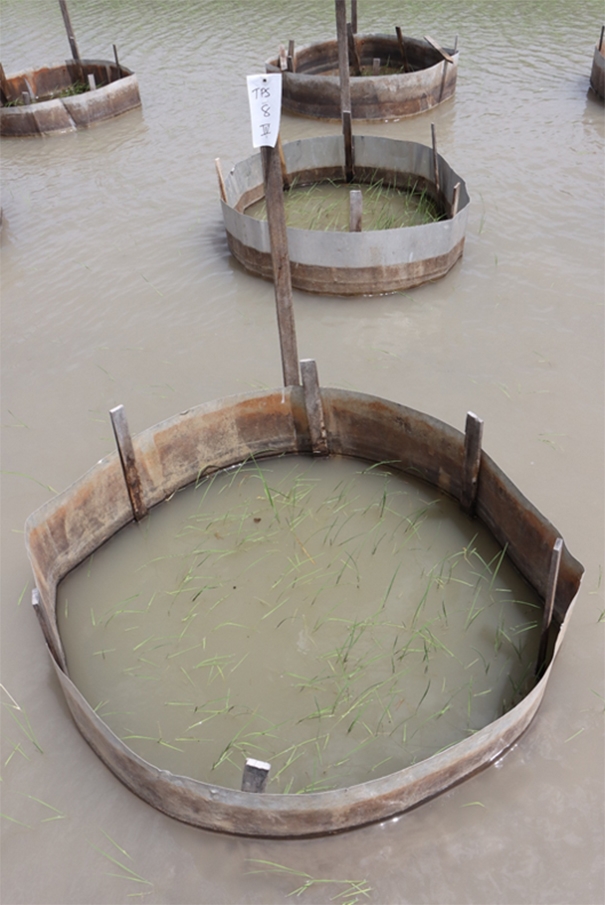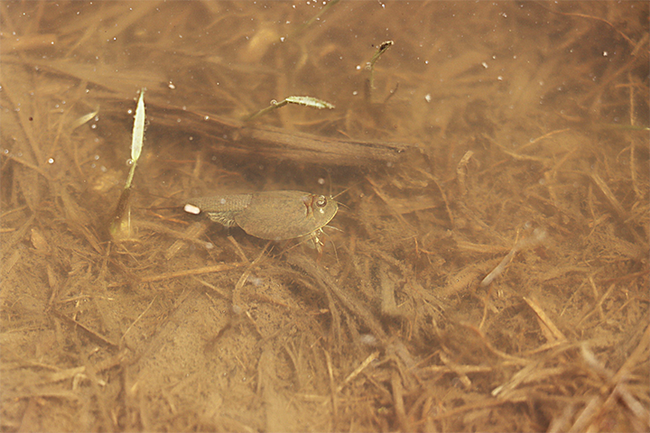
It's neither a tadpole nor a shrimp, but a crustacean pest that feasts on rice seedlings in flooded rice fields.
Rice growers currently rely heavily on pyrethroid insecticides to manage tadpole shrimp.
At the Entomological Society of America meeting this week in Denver, agricultural entomologist and Cooperative Extension specialist Ian Grettenberger of the UC Davis Department of Entomology and Nematology and his colleagues proposed alternative management.
Grettenberger's poster, “Past Pyrethroids: Alternative Management Approaches for Tadpole Shrimp in Rice,” offers non-pesticide alternatives, including the use of mosquitofish.
Collaborative research with UCCE Butte County director and Rice Farming Systems Advisor Luis Espino and UC Davis staff research associate Kevin Goding, indicates that mosquitofish proved able to suppress shrimp populations.
“Tadpole shrimp (Triops longicaudatus) are an early-season pest in California rice,” Grettenberger explained in his abstract. “Soon after flooding, eggs hatch and growing shrimp are soon large enough to damage germinating rice seedlings. Currently, pyrethroid insecticides are heavily relied upon for management, as they are in many cropping systems, because of their efficacy and low cost. However, contamination of surface waters is a concern, as is insecticide resistance.”

“In addition, we used large square metal plots to evaluate if a fish released for mosquito control, mosquitofish (Gambusia affinis), could suppress shrimp populations. We found that a number of materials could suppress shrimp populations, while unregistered materials did not provide sufficient control. Mosquitofish also proved able to suppress shrimp populations, although extremely high shrimp populations could escape predation and shrimp could outgrow risk to predators. These results could help a field crop industry move beyond pyrethroids, which will be important to address issues of environmental contamination or regulatory changes as well as changes in susceptibility.”
Deep Look Video. Tadpole shrimp recently made the national news in two ways, Grettenberger said. First, they made news with the sudden appearance of tadpole shrimp following monsoon rains this summer in an ancient ceremonial ball court at the Wupatki National Monument in northern Arizona (https://www.livescience.com/dinosaur-shrimp-emerge-arizona). In October, KQED's Deep Look released a new video, “Tadpole Shrimp Are Coming For Your Rice," the work of lead producer and cinematographer Josh Cassidy and other members of the Deep Look crew. (See https://youtu.be/T2xnXaX7r3g.) Grettenberger assisted with the project, providing tadpole shrimp and taking some of the video clips used in the five-minute video.
“Much of his shooting was in my garage,” the UC Davis entomologist said, “so I get to see just how much effort and care goes into producing these videos. They end up pretty short, but that doesn't mean it is simple to get all the pieces together.”
“This tadpole shrimp is coming for your rice,” the narrator said. “Hungry hordes of them find their way into the ice fields of California's Central Valley and go to town munching on the young seedlings. But where did they come from, with the ocean so far away? A couple of weeks ago, this was just a dry dusty field. Turns out they were here all along.”
Deep Look referred to them as “time travelers,” as the eggs of shrimp tadpoles can be viable for decades and hatch when the rice growers flood their fields. "At the very least, they have survived as eggs since last season," Grettenberger noted.
The pests are neither tadpoles or shrimp but are fresh-water crustaceans descended from the ocean. “They look like tiny horseshoe crabs,” Grettenberger told Deep Look. “It's obvious when rice fields have lots of tadpole shrimp in them, because they stir up the mud making the water look a bit like chocolate milk. There will also be shrimp zooming around, many upside down at the surface, popping up for a few seconds before disappearing back into the murkiness."
Adult tadpole shrimp cannot survive when the soil dries out. But Grettenberger said their eggs have a rugged outer layer called a “chorion” that protects the eggs from desiccation.
“They've been living this way for hundreds of millions of years-- since before the dinosaurs-- waiting out droughts, changing climates, even global catastrophes,” KQED relates in the video. “In a world where the future is unpredictable, tadpole shrimp are the ultimate survivors.”
Grettenberger, who joined the UC Davis Department of Entomology faculty in January, 2019, focuses his research on field and vegetable crops; integrated pest management; applied insect ecology; and biological control of pests.
Additional Information:
- Resource on tadpole shrimp, UC Statewide Integrated Pest Management Program (co-authors, the late Larry Godfrey, Cooperative Extension specialist, UC Davis Department of Entomology and Nematology; Luis Espino, UC Cooperative Extension; and Sharon Lawler, professor, UC Davis Department of Entomology and Nematology
- "Effect of Rice Winter Cultural Management Practices on the Size of the Hatching Population of Triops longicaudatus (Notostraca:Triopsidae) in California Rice Fields" (Co-authors Larry Godfrey,
Attached Images:

A field trial at the California Cooperative Rice Research Foundation Inc. Rice Experiment Station near Biggs, Calif. (Photo by Ian Grettenberger)

UC Cooperative Extension specialist Ian Grettenberg said that "we evaluated alternative management strategies that could be used to manage tadpole shrimp. We tested a number of materials using small metal ring plots and natural shrimp population. (Photo by Ian Grettenberger)

A tadpole shrimp feasting on rice seedlings. (Photo by Ian Grettenberger)